Chapter 12. Sources of Magnetic Fields
12.1 The Biot-Savart Law
Learning Objectives
By the end of this section, you will be able to:
- Explain how to derive a magnetic field from an arbitrary current in a line segment
- Calculate magnetic field from the Biot-Savart law in specific geometries, such as a current in a line and a current in a circular arc
We have seen that mass produces a gravitational field and also interacts with that field. Charge produces an electric field and also interacts with that field. Since moving charge (that is, current) interacts with a magnetic field, we might expect that it also creates that field—and it does.
The equation used to calculate the magnetic field produced by a current is known as the Biot-Savart law. It is an empirical law named in honor of two scientists who investigated the interaction between a straight, current-carrying wire and a permanent magnet. This law enables us to calculate the magnitude and direction of the magnetic field produced by a current in a wire. The Biot-Savart law states that at any point P (Figure 12.2), the magnetic field [latex]d\stackrel{\to }{\textbf{B}}[/latex] due to an element [latex]d\stackrel{\to }{\textbf{l}}[/latex] of a current-carrying wire is given by
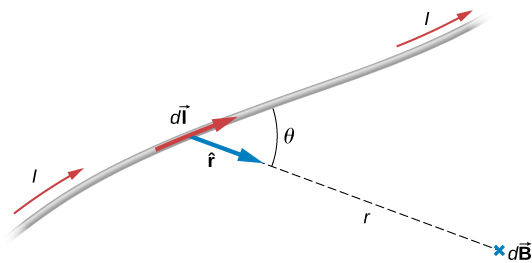
The constant [latex]{\mu }_{0}[/latex] is known as the permeability of free space and is exactly
in the SI system. The infinitesimal wire segment [latex]d\stackrel{\to }{\textbf{l}}[/latex] is in the same direction as the current I (assumed positive), r is the distance from [latex]d\stackrel{\to }{\textbf{l}}[/latex] to P and [latex]\hat{\textbf{r}}[/latex] is a unit vector that points from [latex]d\stackrel{\to }{\textbf{l}}[/latex] to P, as shown in the figure.
The direction of [latex]d\stackrel{\to }{\textbf{B}}[/latex] is determined by applying the right-hand rule to the vector product [latex]d\stackrel{\to }{\textbf{l}}\phantom{\rule{0.2em}{0ex}}×\phantom{\rule{0.2em}{0ex}}\hat{\textbf{r}}.[/latex] The magnitude of [latex]d\stackrel{\to }{\textbf{B}}[/latex] is
where [latex]\theta[/latex] is the angle between [latex]d\stackrel{\to }{\textbf{l}}[/latex] and [latex]\hat{\textbf{r}}.[/latex] Notice that if [latex]\theta =0,[/latex] then [latex]d\stackrel{\to }{\textbf{B}}=\stackrel{\to }{\textbf{0}}.[/latex] The field produced by a current element [latex]Id\stackrel{\to }{\textbf{l}}[/latex] has no component parallel to [latex]d\stackrel{\to }{\textbf{l}}.[/latex]
The magnetic field due to a finite length of current-carrying wire is found by integrating Equation 12.3 along the wire, giving us the usual form of the Biot-Savart law.
Biot-Savart law
The magnetic field [latex]\stackrel{\to }{\textbf{B}}[/latex] due to an element [latex]d\stackrel{\to }{\textbf{l}}[/latex] of a current-carrying wire is given by
Since this is a vector integral, contributions from different current elements may not point in the same direction. Consequently, the integral is often difficult to evaluate, even for fairly simple geometries. The following strategy may be helpful.
Problem-Solving Strategy: Solving Biot-Savart Problems
To solve Biot-Savart law problems, the following steps are helpful:
- Identify that the Biot-Savart law is the chosen method to solve the given problem. If there is symmetry in the problem comparing [latex]\stackrel{\to }{\textbf{B}}[/latex] and [latex]d\stackrel{\to }{\textbf{l}},[/latex] Ampère’s law may be the preferred method to solve the question.
- Draw the current element length [latex]d\stackrel{\to }{\textbf{l}}[/latex] and the unit vector [latex]\hat{\textbf{r}},[/latex] noting that [latex]d\stackrel{\to }{\textbf{l}}[/latex] points in the direction of the current and [latex]\hat{\textbf{r}}[/latex] points from the current element toward the point where the field is desired.
- Calculate the cross product [latex]d\stackrel{\to }{\textbf{l}}\phantom{\rule{0.2em}{0ex}}×\phantom{\rule{0.2em}{0ex}}\hat{\textbf{r}}.[/latex] The resultant vector gives the direction of the magnetic field according to the Biot-Savart law.
- Use Equation 12.4 and substitute all given quantities into the expression to solve for the magnetic field. Note all variables that remain constant over the entire length of the wire may be factored out of the integration.
- Use the right-hand rule to verify the direction of the magnetic field produced from the current or to write down the direction of the magnetic field if only the magnitude was solved for in the previous part.
Example
Calculating Magnetic Fields of Short Current Segments
A short wire of length 1.0 cm carries a current of 2.0 A in the vertical direction (Figure 12.3). The rest of the wire is shielded so it does not add to the magnetic field produced by the wire. Calculate the magnetic field at point P, which is 1 meter from the wire in the x-direction.
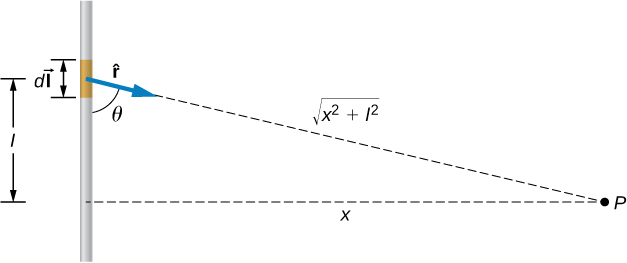
Strategy
We can determine the magnetic field at point P using the Biot-Savart law. Since the current segment is much smaller than the distance x, we can drop the integral from the expression. The integration is converted back into a summation, but only for small dl, which we now write as [latex]\text{Δ}l.[/latex] Another way to think about it is that each of the radius values is nearly the same, no matter where the current element is on the line segment, if [latex]\text{Δ}l[/latex] is small compared to x. The angle [latex]\theta[/latex] is calculated using a tangent function. Using the numbers given, we can calculate the magnetic field at P.
Solution
Show Answer
The angle between [latex]\text{Δ}\stackrel{\to }{\textbf{l}}[/latex] and [latex]\hat{\textbf{r}}[/latex] is calculated from trigonometry, knowing the distances l and x from the problem:
The magnetic field at point P is calculated by the Biot-Savart law:
From the right-hand rule and the Biot-Savart law, the field is directed into the page.
Significance
This approximation is only good if the length of the line segment is very small compared to the distance from the current element to the point. If not, the integral form of the Biot-Savart law must be used over the entire line segment to calculate the magnetic field.
Check Your Understanding
Using Example 12.1, at what distance would P have to be to measure a magnetic field half of the given answer?
Show Solution
1.41 meters
Example
Calculating Magnetic Field of a Circular Arc of Wire
A wire carries a current I in a circular arc with radius R swept through an arbitrary angle [latex]\theta[/latex] (Figure 12.4). Calculate the magnetic field at the center of this arc at point P.
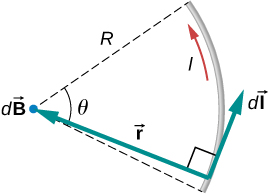
Strategy
We can determine the magnetic field at point P using the Biot-Savart law. The radial and path length directions are always at a right angle, so the cross product turns into multiplication. We also know that the distance along the path dl is related to the radius times the angle [latex]\theta[/latex] (in radians). Then we can pull all constants out of the integration and solve for the magnetic field.
Solution
Show Answer
The Biot-Savart law starts with the following equation:
As we integrate along the arc, all the contributions to the magnetic field are in the same direction (out of the page), so we can work with the magnitude of the field. The cross product turns into multiplication because the path dl and the radial direction are perpendicular. We can also substitute the arc length formula, [latex]dl=rd\theta[/latex]:
The current and radius can be pulled out of the integral because they are the same regardless of where we are on the path. This leaves only the integral over the angle,
The angle varies on the wire from 0 to [latex]\theta[/latex]; hence, the result is
Significance
The direction of the magnetic field at point P is determined by the right-hand rule, as shown in the previous chapter. If there are other wires in the diagram along with the arc, and you are asked to find the net magnetic field, find each contribution from a wire or arc and add the results by superposition of vectors. Make sure to pay attention to the direction of each contribution. Also note that in a symmetric situation, like a straight or circular wire, contributions from opposite sides of point P cancel each other.
Check Your Understanding
The wire loop forms a full circle of radius R and current I. What is the magnitude of the magnetic field at the center?
Show Solution
[latex]\frac{{\mu }_{0}I}{2R}[/latex]
Summary
- The magnetic field created by a current-carrying wire is found by the Biot-Savart law.
- The current element [latex]Id\stackrel{\to }{\textbf{l}}[/latex] produces a magnetic field a distance r away.
Conceptual Questions
For calculating magnetic fields, what are the advantages and disadvantages of the Biot-Savart law?
Show Solution
Biot-Savart law’s advantage is that it works with any magnetic field produced by a current loop. The disadvantage is that it can take a long time.
Describe the magnetic field due to the current in two wires connected to the two terminals of a source of emf and twisted tightly around each other.
How can you decide if a wire is infinite?
Show Solution
If you were to go to the start of a line segment and calculate the angle [latex]\theta[/latex] to be approximately [latex]0\text{°}[/latex], the wire can be considered infinite. This judgment is based also on the precision you need in the result.
Identical currents are carried in two circular loops; however, one loop has twice the diameter as the other loop. Compare the magnetic fields created by the loops at the center of each loop.
Problems
A 10-A current flows through the wire shown. What is the magnitude of the magnetic field due to a 0.5-mm segment of wire as measured at (a) point A and (b) point B?
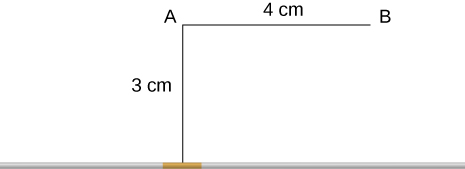
Ten amps flow through a square loop where each side is 20 cm in length. At each corner of the loop is a 0.01-cm segment that connects the longer wires as shown. Calculate the magnitude of the magnetic field at the center of the loop.

Show Solution
[latex]1\phantom{\rule{0.2em}{0ex}}×\phantom{\rule{0.2em}{0ex}}{10}^{-8}\text{T}[/latex]
What is the magnetic field at P due to the current I in the wire shown?
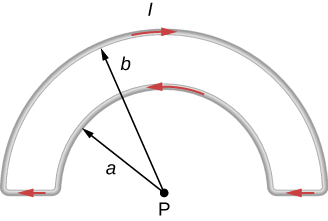
The accompanying figure shows a current loop consisting of two concentric circular arcs and two perpendicular radial lines. Determine the magnetic field at point P.
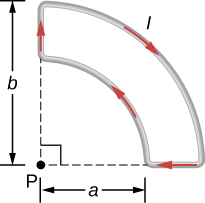
Show Solution
[latex]B=\frac{{\mu }_{o}I}{8}\left(\frac{1}{a}-\phantom{\rule{0.05em}{0ex}}\frac{1}{b}\right)[/latex] out of the page
Find the magnetic field at the center C of the rectangular loop of wire shown in the accompanying figure.
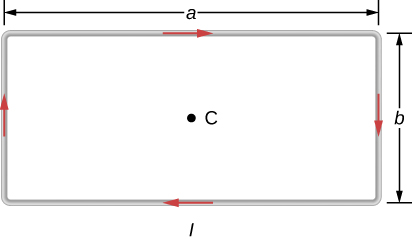
Two long wires, one of which has a semicircular bend of radius R, are positioned as shown in the accompanying figure. If both wires carry a current I, how far apart must their parallel sections be so that the net magnetic field at P is zero? Does the current in the straight wire flow up or down?
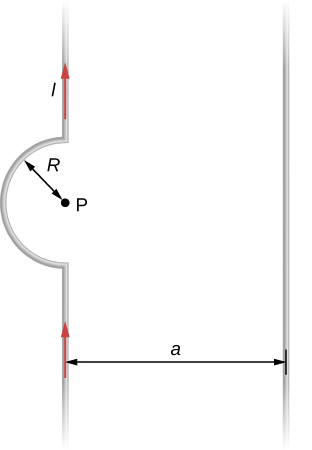
Show Solution
[latex]a=\frac{2R}{\pi }[/latex]; the current in the wire to the right must flow up the page.
Glossary
- Biot-Savart law
- an equation giving the magnetic field at a point produced by a current-carrying wire
- permeability of free space
- [latex]{\mu }_{0},[/latex] measure of the ability of a material, in this case free space, to support a magnetic field
Licenses and Attributions
The Biot-Savart Law. Authored by: OpenStax College. Located at: https://openstax.org/books/university-physics-volume-2/pages/12-1-the-biot-savart-law. License: CC BY: Attribution. License Terms: Download for free at https://openstax.org/books/university-physics-volume-2/pages/1-introduction

